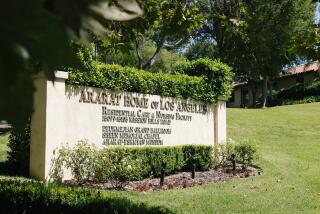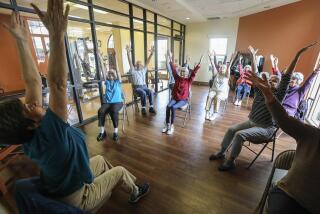Half of State’s Nursing Homes Fall Short in Federal Study
WASHINGTON — More than half of California’s nursing homes fail to provide residents with proper daily care to assure personal cleanliness, and nearly half the facilities do not meet sanitary standards for food storage and preparation, the federal government said Thursday in its first national report card on nursing homes.
The report includes state inspection reports on Orange County’s 47 nursing homes. State health officials said Thursday that the county’s nursing homes reflect the statewide picture--neither better nor worse than the statewide average.
About 40% of the state’s homes do not follow proper techniques in isolating patients to prevent the spread of infection, according to the report by the Health Care Financing Administration. This is a particular threat among the fragile population of nursing homes, where the average resident is over 80 years old.
Nationally, the study found that 40% of the country’s 15,000 nursing homes do not meet sanitary standards for food, and more than 25% fail to administer drugs properly.
The federal report “is a major step forward in presenting information that can be helpful to average persons seeking a nursing home for themselves or members of their families,” Dr. William Roper, head of the Health Care Financing Administration, told a press conference.
However, Roper and other officials were quick to add that the report should be viewed as a starting point for consumers, rather than a definitive ranking of facilities.
“We are convinced that the quality of care in nursing homes is better than it has ever been, but it can be yet better,” Roper said.
In Orange County, Joan Dowling, regional administrator for the state Department of Health Services Licensing and Certification Division, said the new guide will probably put more pressure on the nursing home industry to maintain proper standards.
“That part is good,” she said, but Dowling added that the guide will not be of much use to the consumer because the reports do not specify how big or small a problem may be in any nursing home.
She also said the guide is based on state inspection reports that, in many cases, are a year or more old. “Many things could have changed during that time,” she said.
Dowling said consumers trying to make a choice about a nursing home “should personally visit the facility,” as well as read state inspection reports on the nursing homes.
In Orange County, annual reports on nursing homes are available in Room 850 of the State Office Building at Civic Center Plaza in Santa Ana. The office does not give summaries of its inspection reports over the telephone.
The survey issued Thursday lists 32 performance categories, giving prospective consumers a unique guide to the nation’s nursing homes that participate in the Medicare and Medicaid programs. The individual nursing homes were designated as having “met” or “not met” each of 32 standards of patient care. The 32 were selected from a field of 500 performance indicators for health, safety and treatment.
The federal government does not carry out its own inspections in nursing homes but instead relies on personnel of state agencies. The information has traditionally been fed into a central computer system. The federal study marks the first time it has been summarized and published with a view to comparing nursing home performance.
The California information--contained in four volumes and thousands of pages--highlights some major problems in the state compared to the nation. The major problem areas in California were:
- 26% of the homes failed to give residents sufficient privacy during treatment and care of personal needs. The national failure rate was 17.1%
- 44.6% failed to assure that “food is stored, refrigerated, prepared, distributed and served under sanitary conditions.” The national rate was 42.8%.
- 55.5% failed to assure that “each resident receives daily personal hygiene as needed to assure cleanliness, good skin care, good grooming and oral hygiene.” The national rate was 29.8%.
- 33.5% of homes failed to provide proper routine care for residents with catheters. The national figure was 17.6%
- 38.2% of the facilities failed to provide rehabilitation care to assure that residents do not lose their ability to walk or move freely. The national rate was 21.6%.
- 29.3% of homes failed to give prompt help for those needing assistance in eating or drinking. The national figure was 17.6%.
- 42% failed to administer drugs according to doctors’ orders. The national figure was 29%.
- 24.5% failed to keep electrical and mechanical equipment in safe operating condition. The national figure was 14.9%
- 41.7% failed to follow correct isolation techniques to prevent the spread of infection. The national figure was 24.7%.
However, state health officials said that this is not a reflection of poorer patient care, but rather of stricter performance standards that nursing home operators are required to meet under state law.
Teresa Hawkes, deputy director of the state’s Department of Health Services, and Dowling, the regional state health official in Orange County, both said that in California, inspectors are more likely to uncover federal violations because they must examine homes very thoroughly to see whether stricter California licensing requirements have been met.
Jacqueline Lincer, district administrator for the state Department of Health Services’ Licensing and Certification Division, said Thursday that Orange County nursing homes “are typical of those elsewhere in the state.”
Lincer said of the county’s 47 nursing homes, only about nine have continuing problems and are considered “marginal.”
She said inspectors in her district, which is based in Santa Ana, “constantly monitor” the problem facilities, with all facilities, by state law, inspected at least once a year.
A major shortcoming of the federal study, Hawkes said, is that it does not indicate the severity of a violation. For example, she said, the study does not show whether a violation for improper food storage stems from a freezer that is off by 1 degree or 20 degrees.
Furthermore, the study does not reflect a nursing home’s performance over time, but is rather a “snapshot” of the care provided during a single survey visit that may have occurred “as much as a year and a half ago,” Hawkes said. “A lot can change during that kind of a time frame.”
The state has developed a methodology for measuring the cumulative demerits of nursing homes during a 1-year period. The latest state data, however, is not yet ready for release.
Elma Holder, executive director of the National Citizens’ Coalition on Nursing Home Reform, said consumer groups are disappointed with the federal report.
“A very highly sophisticated consumer might be able to use it as a guide, but my mother and most people’s mothers would not be able to use this document.”
Pamala McGovern, executive director of the Orange County Council on Aging, which has an ombudsman program for investigating nursing homes, said Thursday that she also doubts that the new federal guide will be of much use to individual consumers.
She said the best information about nursing homes comes from locally generated inspections and reports.
“I can’t imagine a report at the federal level being of much help,” she said.
Generally Critical
The nursing home industry and some consumer groups have been generally critical of the federal report.
Paul Willging, executive vice president of the American Health Care Assn., which represents 9,000 profit-making nursing homes, said the report “is misleading--it is going to confuse the public.”
The data may “give false impressions and create some hysteria,” added Sheldon Goldberg, president of the American Assn. of Homes for the Aging, which represents nonprofit institutions.
The report “was a good idea,” said David Helmsin of the California Assn. of Health Facilities, which represents 950 of California’s 1,300 nursing homes, “but it’s potentially misleading to the people it was designed to help.” He faulted the study for its “lack of logic” in the selection of just 32 performance indicators.
The 75 volumes in the national study “will not provide final answers but will let people propose thoughtful questions in the selection of nursing homes,” Roper said.
“I think it’s definitely useful,” said Dr. Lynn Soffer of Public Citizen, a consumer advocacy group. In some states, reports by health inspectors are often difficult to obtain and are very hard to read and understand, she said. However, in California, they must by law be posted prominently in every nursing home for visitors to review.
In choosing a nursing home, these reports should be carefully read either at the nursing home or in the local office of the state health department, according to Nina Frazier, the Los Angeles Ombudsman program director for nursing homes, which monitors patient care locally. The ombudsman program telephone number, she said, is (800) 334-9473.
Rosenblatt reported from Washington and Spiegel from Los Angeles. Staff writer Bill Billiter contributed from Orange County.
More to Read
Sign up for Essential California
The most important California stories and recommendations in your inbox every morning.
You may occasionally receive promotional content from the Los Angeles Times.










